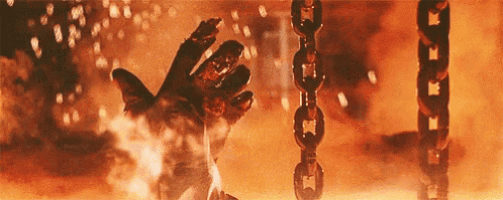Terminator: Dark Fate is a step too far. This entire franchise should be erased from existence

The narratives of the Terminator franchise are now so hopelessly scrambled that there is only one option left, according to critic Luke Buckmaster: burn the entire series to the ground.
The opening scenes of Terminator: Dark Fate show the franchise’s distinctive, skeletal-looking cyborgs stomping around on a beach and blasting their lasers every which-way. Narrator Sarah Connor (Linda Hamilton) informs us that this is “a future without hope” – an almost optimistic-sounding outlook for the human race, given the mood of the current times and our myriad planet-engulfing crises. But, phew! “That future never happened,” she continues, “because I stopped it…to save us all.”
Thank goodness. The whole apocalypse and robot uprising thing could have been a bit hairy. How exactly did this tough-as-nails heroine rescue the world from oblivion? Let’s not get into that. Partly because it was explored all those years ago in Terminator 2: Judgement Day, when Connor stopped the robot apocalypse by preventing Skynet from coming into existence: a tech twist on the old ‘kill ya mother before ya born’ caper. And partly because we’re all pretty bloody confused by everything that’s happened since.
In Terminator 3: Rise Against the Machines (2003), John Connor (played by Nick Stahl, replacing Edward Furlong) has been living off-the-grid after the death of Sarah (his mother). In Terminator Salvation (2009) he grew into Christian Bale. Meaning, given it is always this way with a Bale performance, that he is constantly pissed off about something – in this instance fallout from a nuclear holocaust, which I suppose is fair enough. In the annoyingly misspelled Terminator Genisys (2015), an alternate timeline removed everything in Rise Against the Machines and Salvation. Jason Clarke played Connor, though his character by this point felt like a simulacra: a copy of something that no longer has an original.
The director of the first two installments, the legendary James Cameron, was pleased with the course correction unveiled in Genisys. A revved-up Cameron declared the franchise had “been reinvigorated” and this addition to the canon heralded a “renaissance.” That renaissance didn’t last long. Terminator: Dark Fate doesn’t just ignore the events of the second and third sequel, but the events of Genisys too – making it, in effect, the fourth remake of the third movie.

It’s as if the producers and copyright holders want us to believe that every Terminator movie other than the first two were dreamt up by audiences. The dud sequels being a sort of collective false memory – like that non-existent 90s movie Shazaam!, which some people are so convinced they saw that they started their own truther movement, connected to the so-called Mandela Effect. The Mandela Effect refers to a “theory that a large group of people with the same false memory used to live in a parallel universe.”
The stupidity with which the architecture of the Terminator franchise has been assembled, disassembled, reassembled, remixed, rebooted, reinterpreted, reworked, redone, reupholstered, rejuvenated and, erm, renaissanced (if they can make up a word, so can I) has unwittingly lead to the creation of something interesting. An unusual synthesis of form and content, not only reflecting core themes but illuminating the mindframe of key characters.
It used to be difficult, for example, to fathom the kind of confusion someone like Sarah Connor must experience when trying to mentally keep track of all those alternative histories and sort-of real and sort-of not timelines. Now it’s easy. Just replay the Terminator movies in your head and ask yourself what happened.
Should we thank the filmmakers for constructing a labyrinthine network of narratives, infused with self-reflexive meta commentary in the form of this infuriatingly mangled chronology? Absolutely not. We should instead – as any fair-minded person would concur – ban them from making any more movies and burn this entire series to the ground. Track down and incinerate any and everything Terminator related. Employ the services of Russian spies and Kim Jong-un’s hackers to delete all evidence of their online existence. Yeah, perhaps I’m not thinking rationally. These stupid movies have rubbed me up the wrong way too many times.
Sorry, Terminator fans: this is not want you want to hear. Hey, I like the first couple of movies too. In fact, if I had the ability to determine the precise circumstances of my death – to formulate the exact cinematic environment surrounding my exit from this mortal coil – I would without question replicate the way Arnold Schwarzenegger went hasta la vista at the end of Judgement Day. That is: being slowly lowered into a vat of molten steel, then, once submerged in this bubbling inferno, my face frying in the lava-like liquid, extending a hand into the air and forming a final thumbs-up before going to that great, hideously hot beyond. It’s a terrific scene that somehow feels both dignified and amazingly stupid.

But that memorable “last” hurrah has now been undermined too many times to count. Schwarzenegger’s titanium endoskeleton is back again in Dark Fate, rendering his exquisite molten steel death scene redundant once more, just like the last time he returned and the time before that. I know: his character is a robot, so there’s all sorts of reasons to justify his return. Not to mention all those “alternate histories.” But too much idiocy has reigned for too long. Stick a fork in this franchise; it’s done. Then burn it to the ground, send the ashes to space, and forget the whole thing ever happened. How’s that for an alternate history?
















